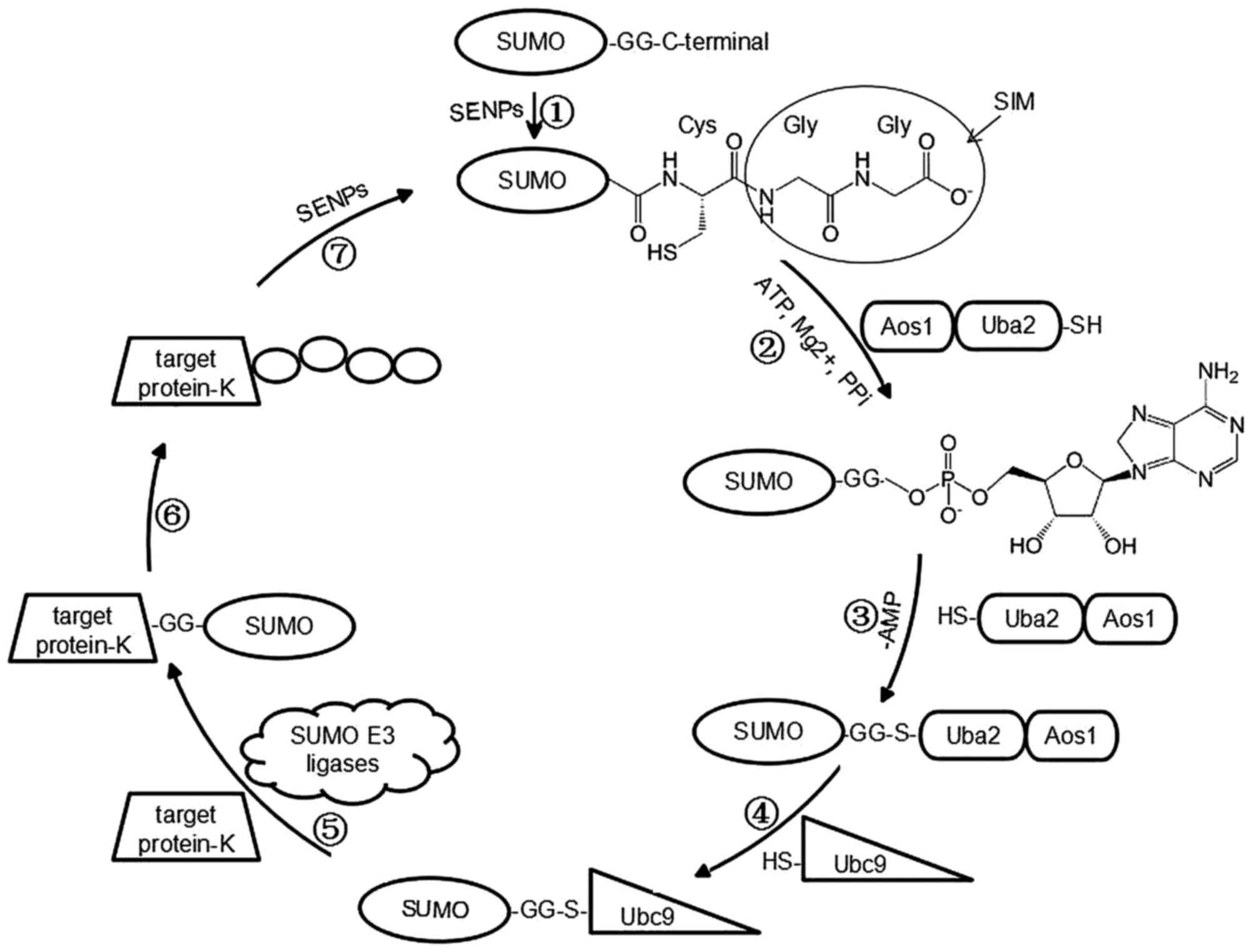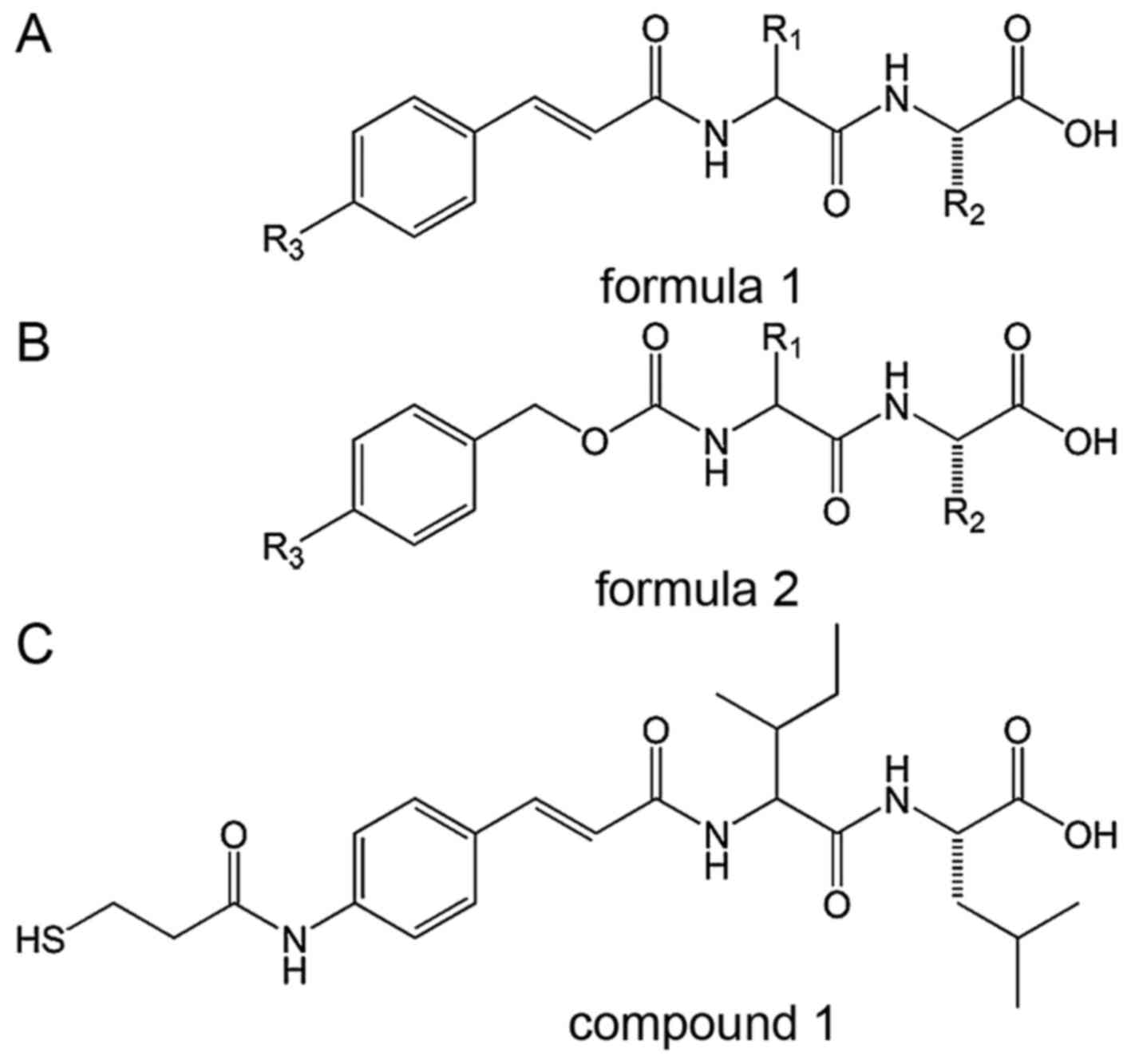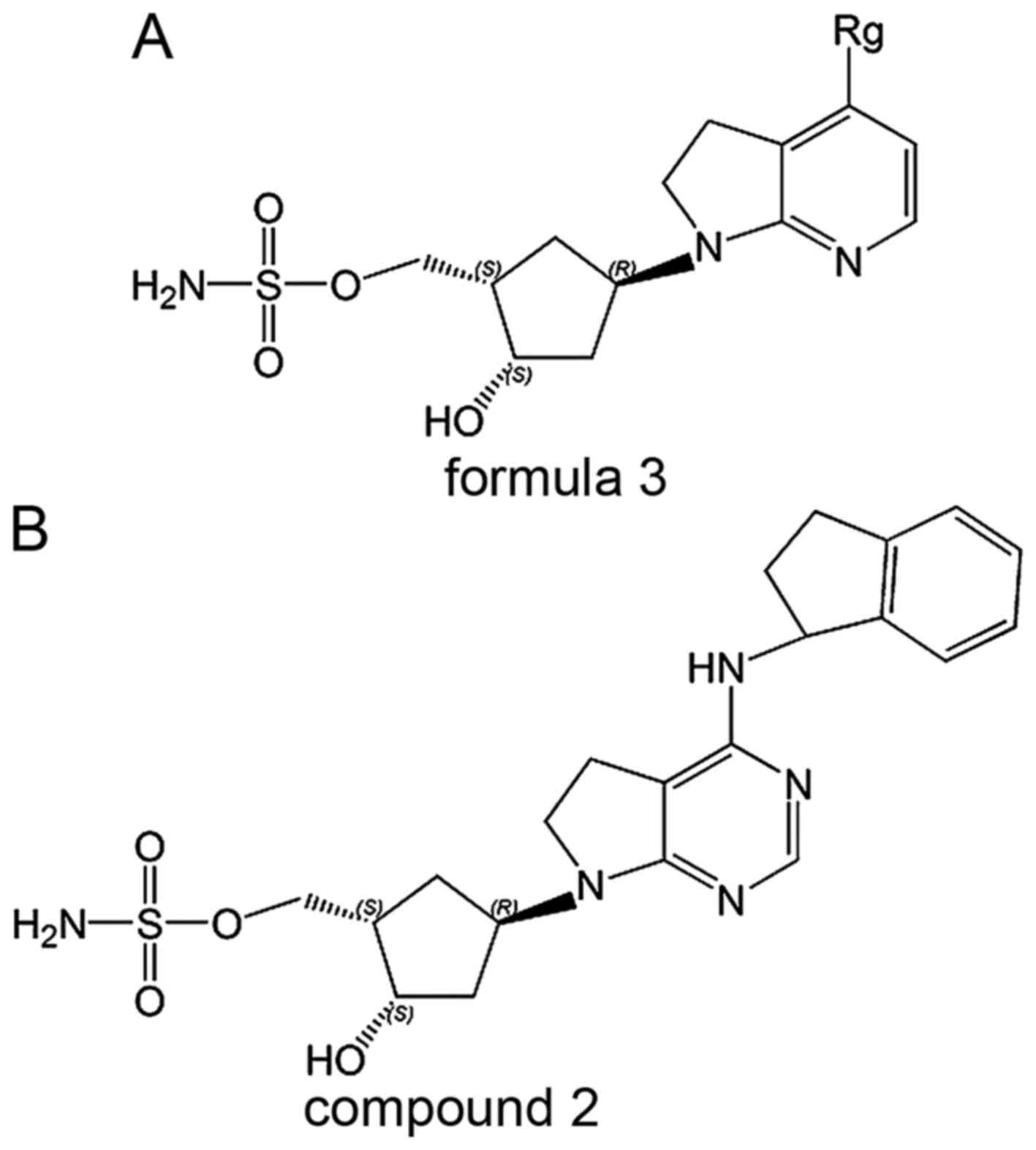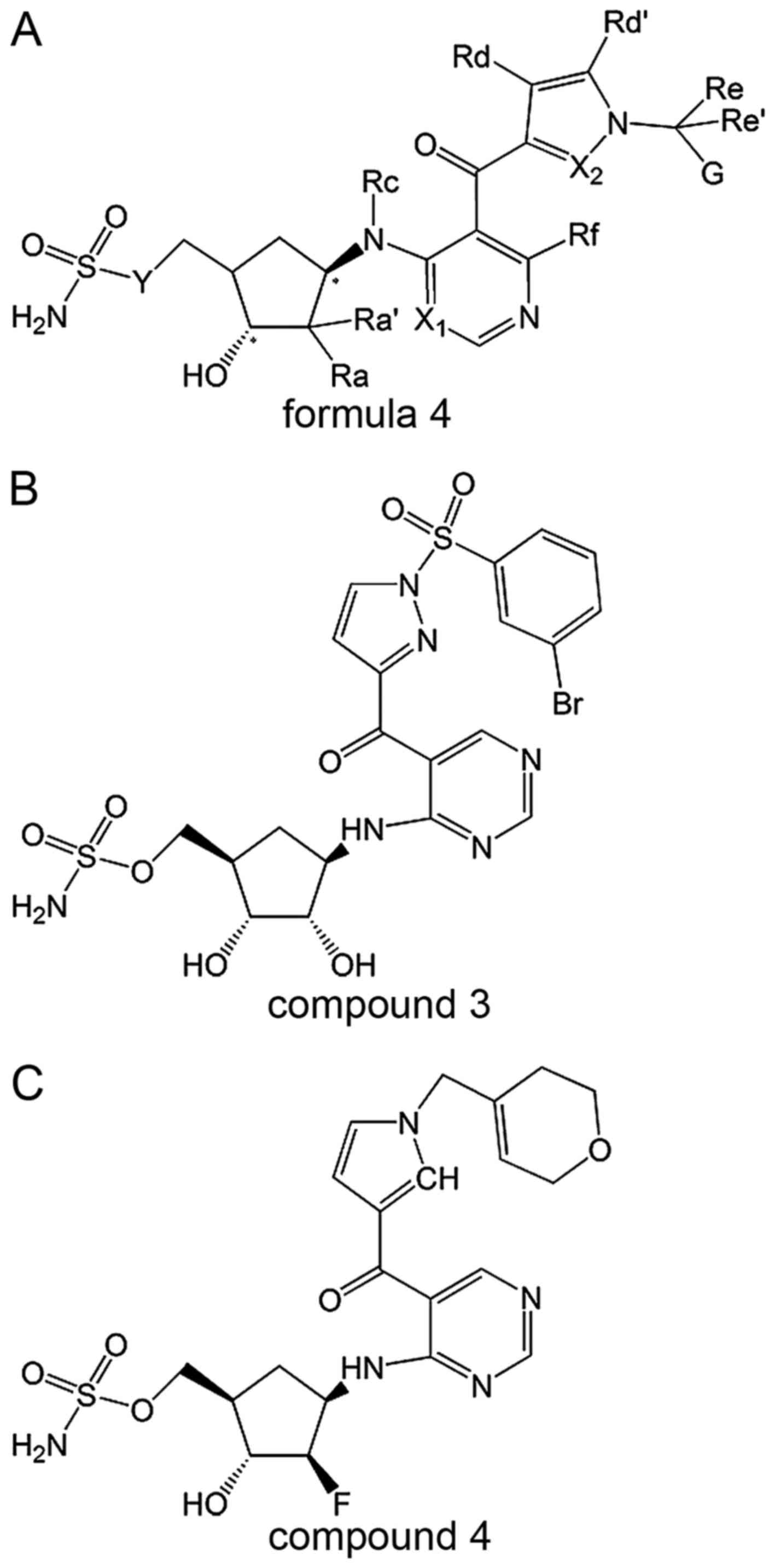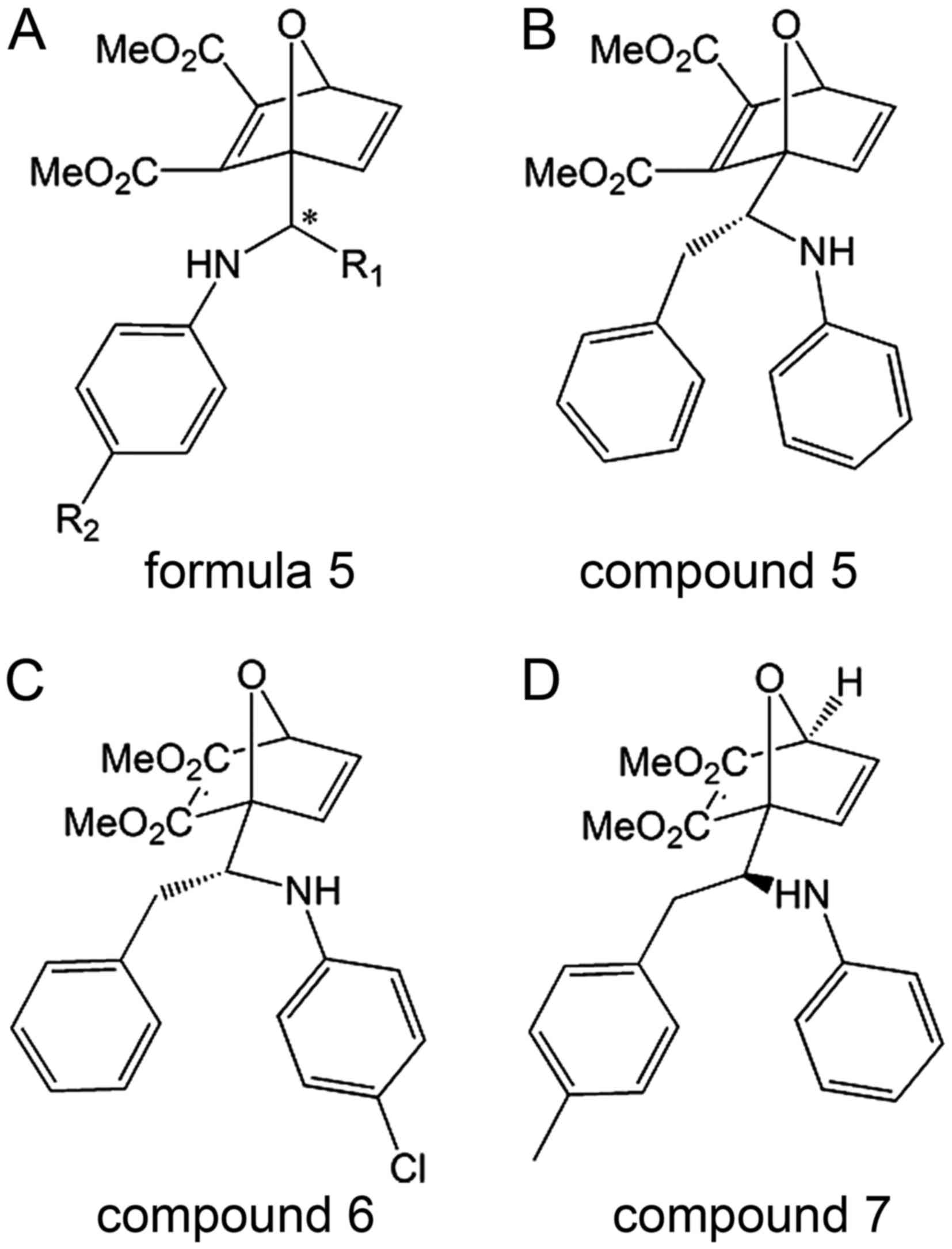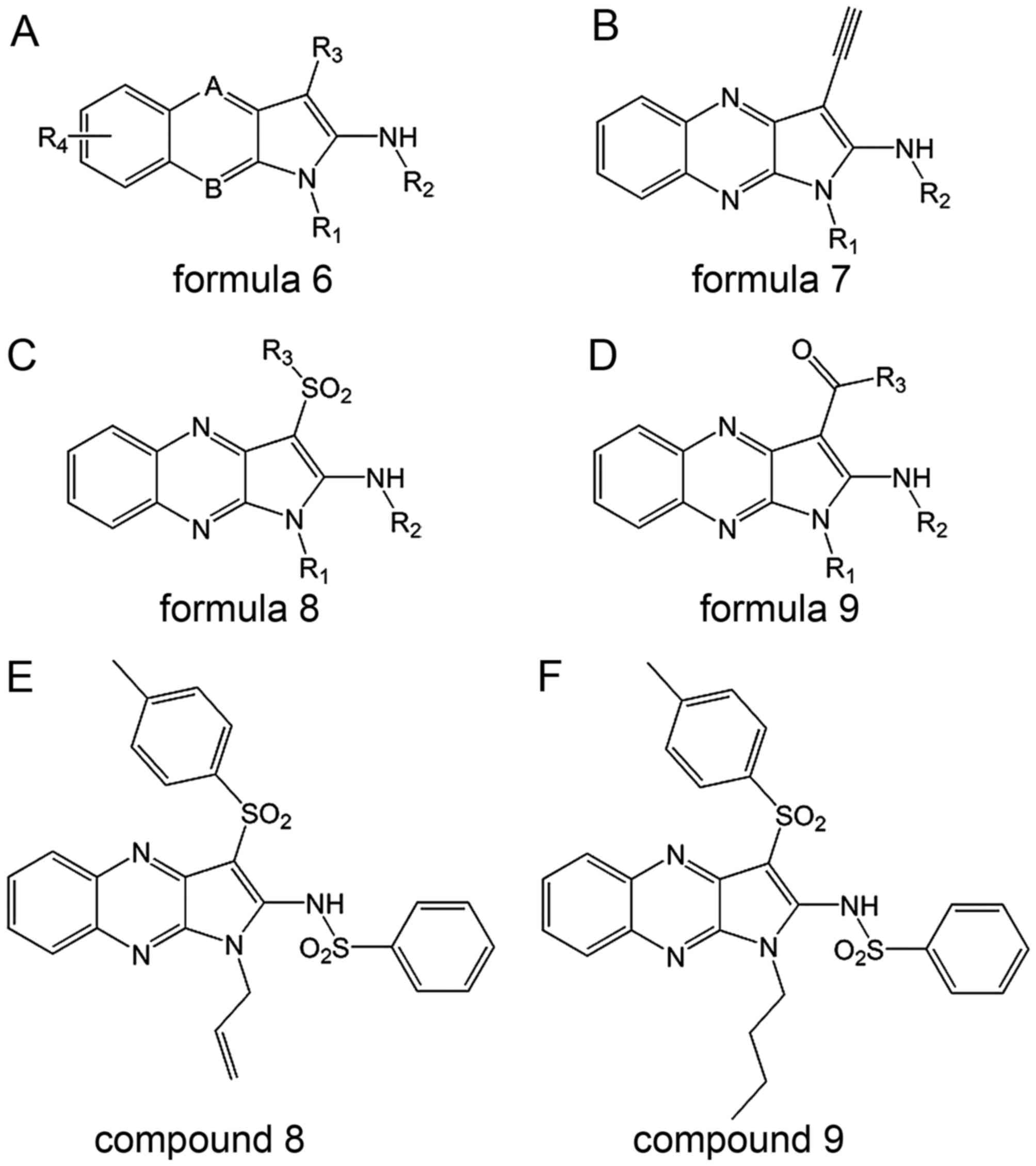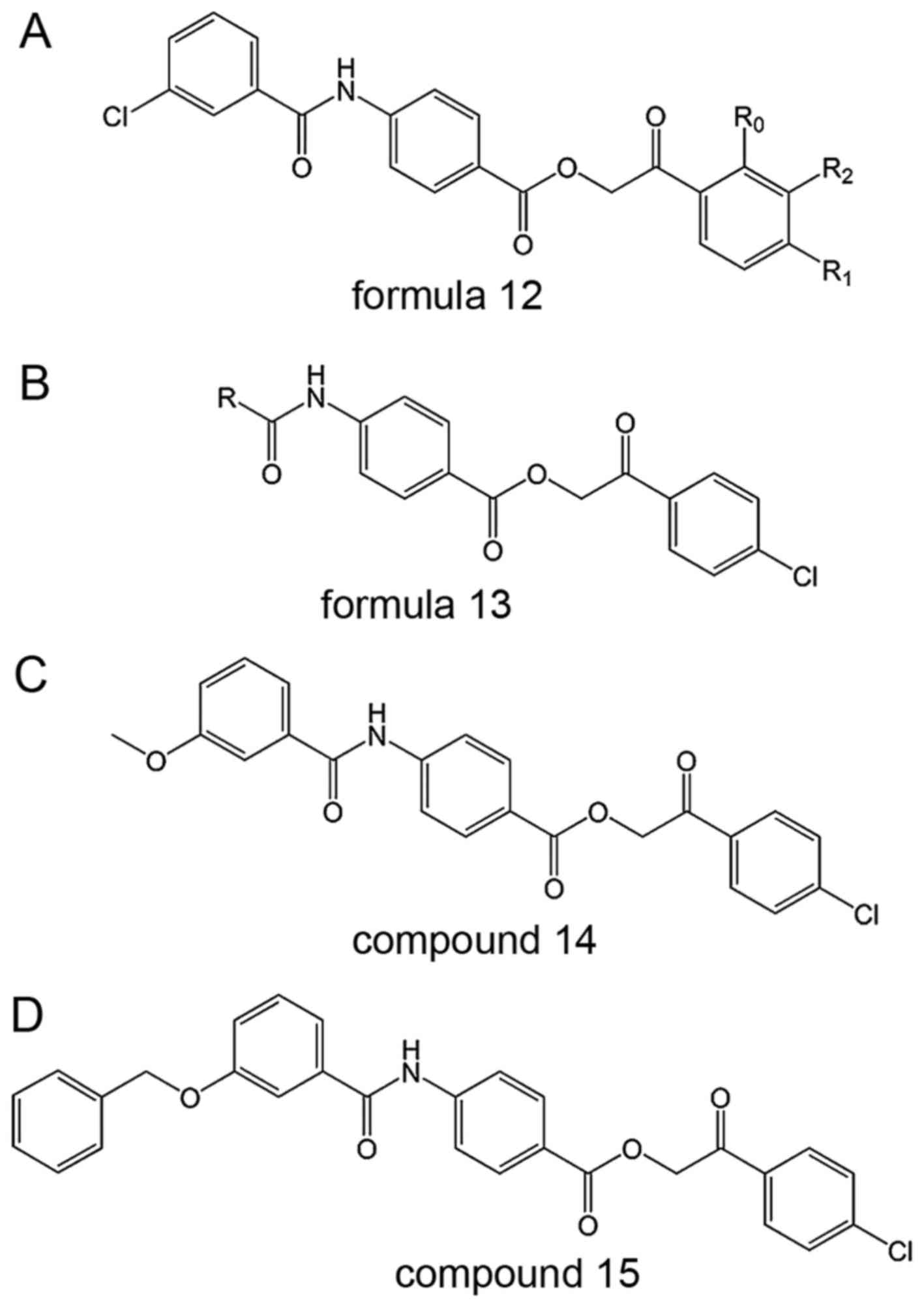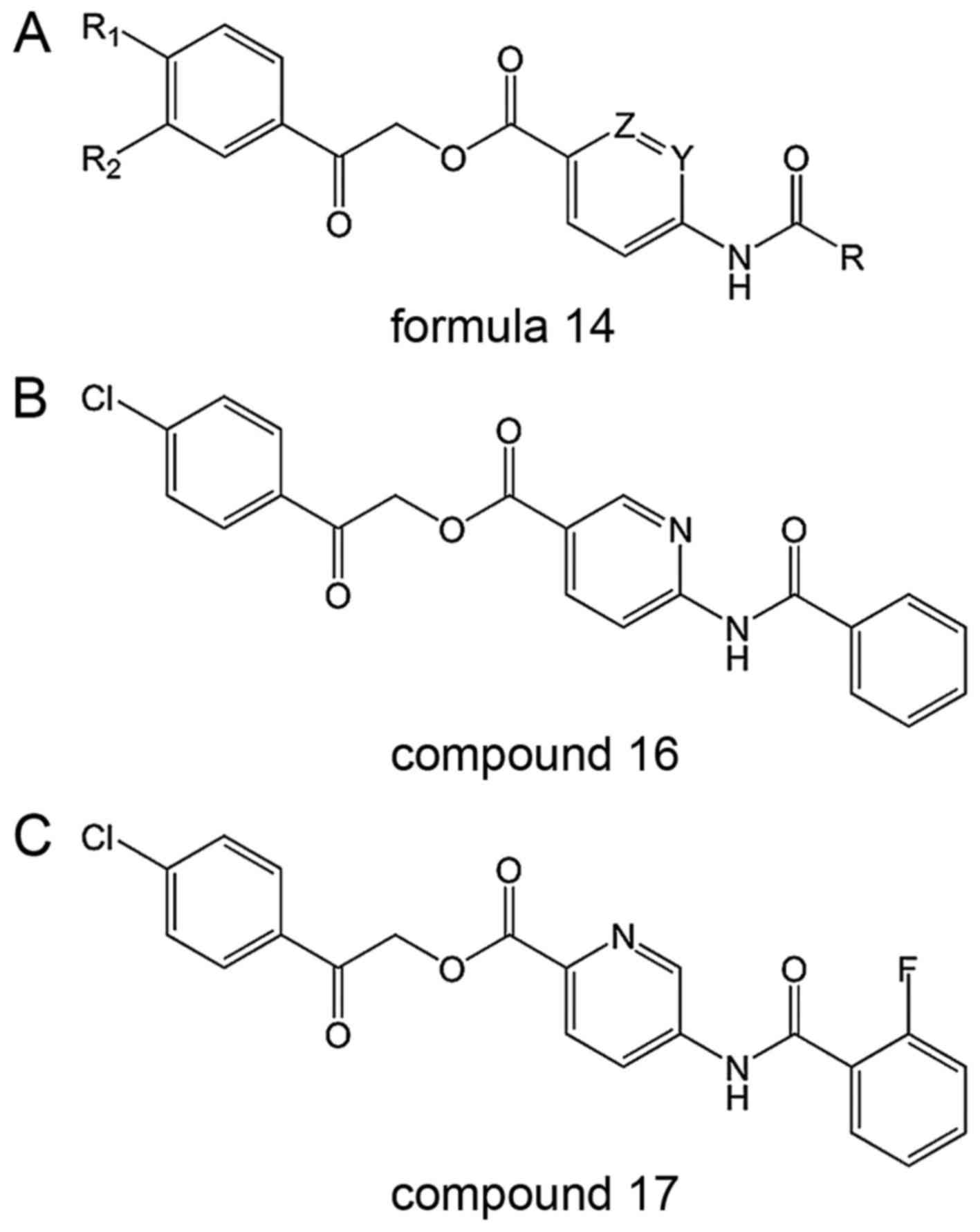Inhibitors targeting the SUMOylation pathway: A patent review 2012‑2015 (Review)
- Authors:
- Published online on: November 1, 2017 https://doi.org/10.3892/ijmm.2017.3231
- Pages: 3-12
Abstract
1. Introduction
Precursor proteins are not active, and thus, need further processing to become functional mature proteins. Post-translational protein modification is the chemical modification of proteins prior to or following protein biosynthesis, and includes phosphorylation, ubiquitylation, methylation, acetylation, and modifications by ubiquitin-like modifiers (Ubls).
Ubiquitin (Ub) is a globular protein consisting of 76 amino acid residues, and the UPS (ubiquitin-proteasome system) is responsible for degrading 80–90% of intracellular proteins. Ub binds the lysine residues of target proteins by a series of enzymes including the ubiquitin-activating enzyme E1, ubiquitin-conjugating enzyme E2 and the ubiquitin E3 ligases. Subsequently, these ubiquitylated proteins are recognized and degraded by the 26S proteasome. Modifications by Ubls are similar to ubiquitylation and they compete for the lysine residues of certain substrates (1).
Small ubiquitin-related modifier (SUMO) proteins are one type of Ubls. Although they only have ~18% sequence identity with ubiquitin, they share a common three-dimensional structure; namely, a globular β-grasp fold and a characteristic C-terminal diglycine (Gly-Gly) motif that is exposed following maturation (2). SUMOs have a flexible, 20 amino acid N-terminus that seems to primarily serve as an acceptor in the formation of poly-SUMO chains (2). Mammalian cells express four SUMO isoforms: SUMO-1, SUMO-2, SUMO-3 and SUMO-4. SUMO1-3 is ubiquitously expressed in human tissues, whereas SUMO4 is only expressed in the kidney, lymph nodes and spleen (3). SUMO-2 and 3 are 95% identical to each other and only 50% identical to SUMO-1 (4); it is not yet clear whether these three isoforms are functionally distinct (6). Unlike SUMO-1, SUMO-2 and 3 have internal SUMO modification sites at their N-termini (K11), which can form poly-SUMO chains (5). The expression level and activity of SUMO proteins affect their conjugation to substrates, although it remains unknown if SUMO-4 can be conjugated to cellular proteins. Similar to the ubiquitylation pathway, SUMO conjugation is reversible and catalyzed by a three-step enzymatic reaction that includes activation, conjugation, and ligation (Fig. 1), which does not result in protein decomposition, but rather, in the regulation of normal cell functions such as protein-protein interactions, subcellular localization, DNA repair, and cell cycle and transcription factor regulation (6).
In SUMOylation, initially, sentrin-specific proteases (SENPs) cleave the C-terminus of SUMO using their endopeptidase activities to expose the Gly-Gly motif required for conjugation, which is also termed the SUMO-interacting motif (SIM) (7–9). SENPs have six isoforms (SENP1, 2, 3, 5, 6 and 7) in mammals, which are divided into three subfamilies based on their sequence homology, substrate specificity, and subcellular localization (10). The catalytic cysteine protease domain at the C-terminus is ~250 amino acid residues in length, and controls the specificity and function of SENP isoforms (11). The catalytic domain crystal structures of SENP1, SENP2 and SENP7, which are comprised of the typical catalytic triad (Cys-His-Asp), are very similar (10). SENP1 and SENP2 have SUMO maturation and deSUMOylation abilities, whereas the other SENPs are unable to induce maturation and prefer SUMO-2/3 over SUMO-1 for deSUMOylation (10,12).
In the second step, SUMO-activating enzyme (SAE) activates the C-terminus of SUMO in a two-step reaction that involves ATP hydrolysis. There is only one heterodimeric E1 enzyme [SAE1/SAE2, also termed activator of SUMO1 (Aos1)/ubiquitin like modifier activating enzyme 2 (Uba2)] involved in the SUMOylation pathway. SAE1 (Aos1) promotes adenylation of the SUMO C-terminus to form the SUMO-adenosine monophosphate (AMP) intermediate, followed by transfer of SUMO to the catalytic Cys173 residue on SAE2 (Uba2) and thioester bond formation (13).
The third step is conjugation. Specifically, SUMO is transferred from SAE to SUMO E2 (also termed ubiquitin conjugating enzyme 2I, UbE2I or Ubc9), again resulting in formation of a thioester linkage between the C-terminal glycine in SUMO and the active site Cys93 residue in Ubc9. Ubc9 is the only known SUMO-conjugating enzyme required for SUMOylation, and its deletion abolishes SUMO conjugation (14).
The fourth step is ligation. Ubc9 catalyzes formation of an isopeptide bond between the C-terminal glycine of SUMO and a lysine residue in the substrate, usually together with a specific SUMO E3 ligase, which increases the efficiency of this reaction by associating with both the substrate protein and Ubc9 (2,15). Specific E3 ligases in mammals include the protein inhibitor of activated STAT-1 (PIAS) protein family (PIAS1, PIAS3, PIASxα, PIASxβ and PIASy), the nucleoporin Ran binding protein 2 and the human polycomb protein Pc2 (2). The tripartite motif family was recently described as a fourth group of SUMO E3 ligases (16).
In the last step, SUMO is removed from the lysine residues of target proteins by SENPs using their isopeptidase activities (10). Ubiquitin-specific protease-like 1 was identified as a new SUMO isopeptidase, with roles in Cajal body functions (17). DeSUMOylating isopeptidase 1 is another SUMO isopeptidase, which recognizes different sets of substrates to SENPs (18).
All SUMOylation proteins are associated with cancer, as elevated levels of SAE, Ubc9, SUMO E3s and SENPs have been observed in various types of cancer (12,14–16). As target proteins of SUMOylation, the Ras-related nuclear protein GTPase-activating protein (RanGAPl), the nuclear factor-κB regulatory inhibitor-α, the tumor suppressor gene p53, the androgen receptor, the progesterone receptor and certain other substrates have been reported (19). The abnormal SUMOylation of these target proteins is also associated with heart disease, diabetes, arthritis, degenerative diseases, and brain ischemia/stroke (6). Thus, there has been growing appreciation for the potential importance of the SUMO conjugation pathway as a target for treating these diseases (20–25).
This review discusses the compounds that inhibit the SUMOylation pathway referred to in patents written in English or Chinese (Table I). These compounds can be divided into four categories according to their mechanisms of action. Category 1 compounds are SUMO mimics that can affect the entire pathway. Category 2 comprises SAE and Ubc9 inhibitors, because all SUMO isoforms are activated and conjugated by SAE and Ubc9. Category 3 compounds are ligation inhibitors because of the specificity of SUMO E3 ligases to target proteins. Category 4 compounds are SENP inhibitors that may inhibit maturation and deSUMOylation.
2. Category 1: SUMO mimics
Multivalent poly-Ubl chain inhibitors (US0302815) (26)
Structure
Multivalent poly-SUMO chain inhibitors comprise gold nanoparticle (AuNP)-ligand conjugates and include at least two components: AuNPs and modified SIM mimics (26). The basic structures (formula 1 and 2) of SIM mimics and potential compound 1 are shown in Fig. 2 (26). The thiol tail [R3= -SH or SH-(CH2)2-CO-NH-] allows the modified SIM mimic to be conjugated to an AuNP by disulfide bonds (26).
Mechanism
The SIM mimic may recapitulate the action of SUMO in protein modification to inhibit the SUMOylation pathway by: i) Forming thioester conjugates with SAE; ii) being transferred from SAE to Ubc9; and iii) being further transferred to the SUMOylation target protein. Once the mimics are conjugated to SAE and Ubc9, they block full-length SUMO from entering the cascade composed of SAE and Ubc9. Thus, SUMO mimics can function as mechanism-based inhibitors of the protein SUMOylation reaction (27). SUMO-2 and 3 are distinct from SUMO-1 in that they harbor internal SUMO modification sites at their N-termini to form poly-SUMO chains (5). Therefore, the conjugation of a weak SUMO-2/3 ligand to AuNPs promotes selective multivalent interactions with poly-SUMO-2/3 chains, resulting in the efficient inhibition of poly-SUMO-chain-mediated protein-protein interactions (5). Metals with high atomic numbers, such as gold, preferentially absorb more X-ray energy than soft tissues, thus augmenting the effects of ionizing radiation when delivered to cells (28,29).
Application
Multivalent poly-SUMO chain inhibitors can kill cancer cells by increasing radiation sensitivity, while sparing normal cells (26). Thus, these inhibitors provide a viable approach for treating cancer by enhancing the effects of ionizing radiation therapy, which is commonly used in cancer treatment. Combining the properties of nanomaterials with nanoparticles as platforms for multivalent interactions creates important potential therapeutic applications (30).
3. Category 2: SUMO enzyme inhibitors
Activating E1 inhibitors (EP2402334) (31)
Structure
There are 86 compounds disclosed in EP2402334, of which most are 4-substituted [(1S,2S,4R)-2-hydroxy-4-{7H-pyrrolo(2,3-d)pyrimidin-7-yl}cyclopentyl)] methyl sulfamates (formula 3; Fig. 3) (31).
Mechanism
The E1 inhibitors described herein are selective and preferably target human NEDD8-activating enzyme (NAE), SAE, or ubiquitin-activating enzyme, with the most preference for NAE (31). The disclosed SAE inhibitors can also be referred to as AMP mimics; they directly bind to SAE1 and inhibit formation of the SAE-SUMO intermediate. MLS 4924 (compound 3; Fig. 3), an AMP mimic, is a selective and highly potent inhibitor of NAE, and also inhibits SAE with a half maximal inhibitory concentration (IC50) value of 8.2 (32).
Application
SAE inhibitors are useful for treating disorders, particularly cell proliferation disorders, including cancer (not limited to solid tumors and hematological tumors), inflammatory and neurodegenerative disorders, and inflammation associated with infection and cachexia (31).
Heteroaryl compounds (WO002994) (33)
Structure
The basic structure (formula 4) of heteroaryl compounds is shown in Fig. 4. The -Y- is often replaced by -O-, -X1- is often replaced by -N-, -X2- is often replaced by -N- or -CH-, Ra can be -OH or -F or -H, and Rc is often replaced by -H. I-1 (compound 4; Fig. 4) and I-5 (compound 5; Fig. 4) are two examples of these heteroaryl compounds (33).
Mechanism
These heteroaryl compounds may be useful as SAE inhibitors (33).
Application
Heteroaryl compounds can be used for the treatment of proliferative, inflammatory, cardiovascular and neurodegenerative disorders (33). The altered expression of proteins in the SAE pathway have been noted in a variety of cancer types including multiple myeloma (MM) (34) and breast cancer (21). In addition, preclinical studies have indicated that Myc-driven cancers may be especially sensitive to SAE inhibition (35).
Singleton inhibitors [US0317101 (36) and WO064898 (37)]
Structure
The structure (formula 5) of singleton inhibitors is presented in Fig. 5 (36,37).
Mechanism
Singleton inhibitors inhibit the function of SAE and/or Ubc9. MLS-0437113 (compound 5; Fig. 4) is the lead and most potent compound in this series, and strongly inhibits SUMO-RanGap1 and Ubc9 conjugation (36,37). MLS-0417120 (compound 6; Fig. 4) is another potential inhibitor (36,37). There are 16 SAE-specific inhibitors in these two patents. MLS-0437317 (compound 7; Fig. 5) is a representative SAE-specific inhibitor that can bind to SAE with high affinity and specificity, and inhibits global SUMOylation in a dose-dependent manner (36,37).
Application
Singleton inhibitors have toxicity in cancer and other diseases by sensitizing cells to genotoxic treatments. Chemoradiotherapy (CRT) is frequently used as a preoperative treatment for colorectal cancer to facilitate surgical intervention and improve long-term survival (38,39). Novel SAE inhibitors can enhance the effects of CRT and/or impair tumor viability, improving treatment outcomes, preserving quality of life and reducing healthcare costs (37). Such inhibitors may be similarly useful in other cancer types (16), diseases, and conditions associated with the overexpression of SAE or Ubc9 (36,37).
Bicyclic and tricyclic inhibitors [WO064897 (40), US0245032 (41) and US9045483 (42)]
Structure
The basic structure in these three patents is formula 6 (Fig. 6). Most tricyclic inhibitors disclosed herein are derived from formulas 7, 8 and 9 (Fig. 6). There are 13 tricyclic SAE inhibitors disclosed in these patents. Compound 8 (Fig. 5) is similar to MLS-0207587 (compound 9; Fig. 6), which also showed an IC50 of 0.5 µM (40–42).
Mechanism
The tricyclic inhibitors competitively inhibit ATP binding, sensitizing cells to genotoxic stress and inhibiting HIV infection. Some compounds also inhibit Ubc9 (40–42).
Application
These inhibitors can be used to treat cancer, degenerative diseases, and viral infections (e.g. HIV). The characterized tricyclic SAE inhibitors may also induce significant sensitivity to radiation in various cancer cell lines (40–42).
Hemopoietic lineage switch 5 polypeptide [EP2545935 (43) and US0330738 (44)]
Structure
Hemopoietic lineage switch 5 (HLS5) is a member of the RING finger B-box coiled-coil protein family. The gene is located on chromosome 8p21, a region implicated in numerous leukemias and solid tumors (45). The overexpression of HLS5 in HeLa cells inhibited cell growth, clonogenicity, and tumorigenicity; thus, it is conceivable that HLS5 is a tumor suppressor protein (46).
Mechanism
HLS5 binds SUMO-1 and is SUMOylated in vivo. It also binds Ubc9 and PIAS1, and has a global effect on SUMOylation by causing the degradation of PIAS1 and Ubc9 through its coiled-coil domain (43,44). In addition, HLS5 also increases the SUMOylation of some proteins. It is possible that the effects of HLS5 are concentration-dependent, in that it may promote greater cell death at higher concentrations (47).
Application
Ligation inhibitors can be used to treat diseases such as Parkinson's disease, diabetes, Huntington's disease, familial neuronal intranuclear inclusion disease, Alzheimer's disease, neuronal intranuclear inclusion disease, cancer (48–52), polyglutamine disease and human immunodeficiency virus (HIV) infection (43,44).
4. Category 3: SENP inhibitors
Inhibitors of deSUMOylation enzymes [WO064887 (53) and US0302525 (54)]
Structure
Compounds 10–11 in Fig. 7 are derived from formula 10 and compounds 12–13 are derived from formula 11 (53,54). They inhibit SENPs and also inhibit HIV infection (55).
Mechanism
SENPs share a conserved catalytic domain that is a cysteine protease of ~225 amino acids (11). Nuclear magnetic resonance and enzyme kinetics data indicate that SENP inhibitors bind in the vicinity of the catalytic center and inhibit the enzyme by a mixed inhibitory mechanism (56). The catalytic domain crystal structures of SENP1, SENP2 and SENP7 are very similar (10). As a result, the inhibitors disclosed herein mostly inhibit SENP1, SENP2 and SENP7.
Application
The SENP inhibitors may sensitize target cells/cancer cells to DNA-damaging therapy, and then minimize or eliminate harm to healthy cells at reduced doses. Inhibitors of deSUMOylation significantly reduce viral infectivity, and limit maintenance of the latent HIV reservoir, which may be valuable to future HIV eradication strategies (57). The SENP inhibitors described herein may also be used to treat cardiovascular disease, neurodegenerative diseases and diabetes in a preventative manner (53,54).
An SENP1 inhibitor: small hairpin RNA [shRNA; CN 104436196 (58)]
Structure
The sequence of the shRNA described herein is 5′-CCGGGCGCCAGAUUGAAGAACAGAACUCGAGUUCUGUUCUUCAAUCUGGCGCUUUUU-3′ (SEQ ID no:1) (58).
Mechanism
The SENP1 inhibitor described herein is an shRNA, including the shRNA recombinant vector and host cells containing the recombinant vector (58). As a precursor of small interfering RNA, shRNA can inhibit expression of the SENP1 protein via the RNA interference mechanism, leading to inhibition of cell proliferation and induction of apoptosis of malignant tumor cells (58).
Application
The SENP1 inhibitors described herein can be used for the preparation of certain special agents that can prevent or treat malignant hematological tumors, and those that inhibit the proliferation of malignant hematological tumor cells and/or promote apoptosis in malignant hematological tumor cells (58).
SENP1 inhibitors [CN 103961348 (59)]
Structure
These SENP1 inhibitors were derived from formula 12 and 13 in Fig. 8 (59), of which the representatives are 2-(4-chlorophenyl)-2-oxoethyl 4-benzamidobenzoate derivatives (60).
Mechanism
The compounds in this patent inhibited the activity of SENP1 in vitro and certain cloned prostate cancer strains (59). Compounds 14 and 15 (Fig. 8) have been reported to have IC50 values of 2.38 and 1.08 µM, respectively (10).
Application
SENP1 affects the function of hypoxia-inducible factor 1α in tumor angiogenesis, thus promoting the development of various tumors (61). The SENP1 inhibitors described herein can inhibit the growth of prostate cancer cells stimulated by androgen (62–64). Thus, these inhibitors may be useful candidate anticancer drugs.
SENP 2 inhibitors [CN 103877078 (65)]
Structure
These inhibitors comprise SENP2 inhibitors containing formula 14 (Fig. 9) as an active ingredient, including its pharmacological derivatives or acceptable salts. This patent has 864 compounds derived from formula 14, differing in Z, Y, R, R1 and R2, compounds 16 and 17 are used here as two examples (65).
Mechanism
The SENP2 inhibitors described have high efficiency and low toxicity, and significantly inhibit SENP2 activity in vitro (65).
Application
The inhibitors of SENP2 described herein can be used to treat breast cancer. By removing the SUMO modification of Pc2 in the protein regulator of cytokinesis 1 protein, the regulation of polycomb group target gene activity is achieved. SENP2 is involved in the regulation of cell differentiation and development, and is highly expressed in a large number of patients with breast cancer (65). Thus, SENP2 inhibitors may be novel drug candidates for anticancer therapy.
5. Discussion
The proteasome inhibitors, bortezomib and carfizomib, which target the ubiquitin pathway, have been used for the treatment of MM and hematologic malignancies (66). The second-generation proteasome inhibitor, carfizomib, induces responses in a minority of patients with MM that relapsed from or were refractory to bortezomib treatment, and experienced dose-limiting peripheral neuropathy. However, carfizomib still results in some adverse reactions that are commonly shared with other antineoplastic agents. To identify more effective agents with less toxicity, inhibitors targeting the SUMOylation pathway have been investigated.
This review summarizes compounds inhibiting the SUMOylation pathway that were described in patents written in English or Chinese between 2012 and 2015. Among these compounds, SAE and SENP1/2 inhibitors appear to have the greatest therapeutic potential, as once protein maturation or activation is blocked, downstream biological events will be inhibited. However, SAE, Ubc9 and SENP1/2 inhibitors do not have target selectivity, whereas SUMO E3 ligases inhibitors may be more selective with fewer side effects.
Research studies should not just focus on SUMO inhibitors, but should also take SUMO activators, such as cysteine protease polypeptides, into consideration (67–70). These proteins function as SENPs, with the ability to cleave SUMO from a target protein and/or cleave the precursor form of SUMO to release its active form. These SENP analogs (cysteine protease poly-peptides) may be useful in the treatment of various cancers and some other diseases related to cysteine family members (71). PIAS1 is a breast cancer suppressor protein (72). An artificial SUMO ligase reportedly promotes the process of ligation (73).
The application of SUMO inhibitors for treating cancer is of utmost importance. Thus, additional studies should focus on identifying the roles of SUMO enzymes in different cancer types. In addition, an understanding of the basic biology and specificity/selectivity of SUMO inhibitors is required before they can be identified and developed for use in the clinic. Although, to date, no SUMO inhibitors have been tested in humans, and further experiments are required in cells and animals, compounds targeting the SUMOylation pathway may represent a new direction for the treatment of cancer and other diseases.
Acknowledgments
This study was sponsored by the grants from the National Natural Science Foundation of China (grant no. 81571568); the Jiangsu Province's Key Provincial Talents Program (grant no. RC201170); the Priority Academic Program Development of Jiangsu Higher Education Institutions (PAPD); the Six Talents Peak projects of Jiangsu Province (to J.-F.W. and H.Y.).
References
|
Herrmann J, Lerman LO and Lerman A: Ubiquitin and ubiquitin-like proteins in protein regulation. Circ Res. 100:1276–1291. 2007. View Article : Google Scholar : PubMed/NCBI | |
|
Flotho A and Melchior F: Sumoylation: A regulatory protein modification in health and disease. Annu Rev Biochem. 82:357–385. 2013. View Article : Google Scholar : PubMed/NCBI | |
|
Bohren KM, Nadkarni V, Song JH, Gabbay KH and Owerbach D: A M55V polymorphism in a novel SUMO gene (SUMO-4) differentially activates heat shock transcription factors and is associated with susceptibility to type I diabetes mellitus. J Biol Chem. 279:27233–27238. 2004. View Article : Google Scholar : PubMed/NCBI | |
|
Geiss-Friedlander R and Melchior F: Concepts in sumoylation: A decade on. Nat Rev Mol Cell Biol. 8:947–956. 2007. View Article : Google Scholar : PubMed/NCBI | |
|
Tatham MH, Jaffray E, Vaughan OA, Desterro JM, botting CH, Naismith JH and Hay RT: Polymeric chains of SUMO-2 and SUMO-3 are conjugated to protein substrates by SAE1/SAE2 and Ubc9. J Biol Chem. 276:35368–35374. 2001. View Article : Google Scholar : PubMed/NCBI | |
|
Yang W and Paschen W: SUMO proteomics to decipher the SUMO-modified proteome regulated by various diseases. Proteomics. 15:1181–1191. 2015. View Article : Google Scholar : | |
|
Hannich JT, Lewis A, Kroetz MB, Li SJ, Heide H, Emili A and Hochstrasser M: Defining the SUMO-modified proteome by multiple approaches in Saccharomyces cerevisiae. J Biol Chem. 280:4102–4110. 2005. View Article : Google Scholar | |
|
Hecker CM, Rabiller M, Haglund K, Bayer P and Dikic I: Specification of SUMO1- and SUMO2-interacting motifs. J Biol Chem. 281:16117–16127. 2006. View Article : Google Scholar : PubMed/NCBI | |
|
Song J, Durrin LK, Wilkinson TA, Krontiris TG and Chen Y: Identification of a SUMO-binding motif that recognizes SUMO-modified proteins. Proc Natl Acad Sci USA. 101:14373–14378. 2004. View Article : Google Scholar : PubMed/NCBI | |
|
Kumar A and Zhang KY: Advances in the development of SUMO specific protease (SENP) inhibitors. Comput Struct Biotechnol J. 13:204–211. 2015. View Article : Google Scholar : PubMed/NCBI | |
|
Hickey CM, Wilson NR and Hochstrasser M: Function and regulation of SUMO proteases. Nat Rev Mol Cell Biol. 13:755–766. 2012. View Article : Google Scholar : PubMed/NCBI | |
|
Bettermann K, Benesch M, Weis S and Haybaeck J: SUMOylation in carcinogenesis. Cancer Lett. 316:113–125. 2012. View Article : Google Scholar | |
|
Olsen SK, Capili AD, Lu X, Tan DS and Lima CD: Active site remodelling accompanies thioester bond formation in the SUMO E1. Nature. 463:906–912. 2010. View Article : Google Scholar : PubMed/NCBI | |
|
Kumar A, Ito A, Hirohama M, Yoshida M and Zhang KY: Identification of sumoylation inhibitors targeting a predicted pocket in Ubc9. J Chem Inf Model. 54:2784–2793. 2014. View Article : Google Scholar : PubMed/NCBI | |
|
Kumar A, Ito A, Hirohama M, Yoshida M and Zhang KY: Identification of sumoylation activating enzyme 1 inhibitors by structure-based virtual screening. J Chem Inf Model. 53:809–820. 2013. View Article : Google Scholar : PubMed/NCBI | |
|
Mattoscio D and Chiocca S: SUMO pathway components as possible cancer biomarkers. Future Oncol. 11:1599–1610. 2015. View Article : Google Scholar : PubMed/NCBI | |
|
Schulz S, Chachami G, Kozaczkiewicz L, Winter U, Stankovic-Valentin N, Haas P, Hofmann K, Urlaub H, Ovaa H, Wittbrodt J, et al: Ubiquitin-specific protease-like 1 (USPL1) is a SUMO isopeptidase with essential, non-catalytic functions. EMbO Rep. 13:930–938. 2012. View Article : Google Scholar : PubMed/NCBI | |
|
Shin EJ, Shin HM, Nam E, Kim WS, Kim JH, Oh BH and Yun Y: DeSUMOylating isopeptidase: A second class of SUMO protease. EMBO Rep. 13:339–346. 2012. View Article : Google Scholar : PubMed/NCBI | |
|
Shirong L and Wei H: Sumoylation - a muitffunctional post-translational protein modification. J Med Mol Biol. 3:212–215. 2006. | |
|
Liu X, Xu Y, Pang Z, Guo F, Qin Q, Yin T, Sang Y, Feng C, Li X, Jiang L, et al: Knockdown of SUMO-activating enzyme subunit 2 (SAE2) suppresses cancer malignancy and enhances chemotherapy sensitivity in small cell lung cancer. J Hematol Oncol. 8:672015. View Article : Google Scholar : PubMed/NCBI | |
|
Chen SF, Gong C, Luo M, Yao HR, Zeng YJ and Su FX: Ubc9 expression predicts chemoresistance in breast cancer. Chin J Cancer. 30:638–644. 2011. View Article : Google Scholar : PubMed/NCBI | |
|
Rabellino A, Carter B, Konstantinidou G, Wu SY, Rimessi A, byers LA, Heymach JV, Girard L, Chiang CM, Teruya-Feldstein J, et al: The SUMO E3-ligase PIAS1 regulates the tumor suppressor PML and its oncogenic counterpart PML-RARA. Cancer Res. 72:2275–2284. 2012. View Article : Google Scholar : PubMed/NCBI | |
|
Li T, Huang S, Dong M, Gui Y and Wu D: Prognostic impact of SUMO-specific protease 1 (SENP1) in prostate cancer patients undergoing radical prostatectomy. Urol Oncol. 31:1539–1545. 2013. View Article : Google Scholar | |
|
Bossis G, Sarry JE, Kifagi C, Ristic M, Saland E, Vergez F, Salem T, Boutzen H, Baik H, Brockly F, et al: The ROS/SUMO axis contributes to the response of acute myeloid leukemia cells to chemotherapeutic drugs. Cell Rep. 7:1815–1823. 2014. View Article : Google Scholar : PubMed/NCBI | |
|
Dassouki Z, Sahin U, El Hajj H, Jollivet F, Kfoury Y, Lallemand-Breitenbach V, Hermine O, de Thé H and Bazarbachi A: ATL response to arsenic/interferon therapy is triggered by SUMO/PML/RNF4-dependent Tax degradation. Blood. 125:474–482. 2015. View Article : Google Scholar | |
|
Chen Y, Horne D, Li YJ, Ma LY, Perkins-Harki AL and Su Y: Multi-valent poly-ubl chain inhibitors and methods of use. US Patent 0302815. Filed February 21, 2012; issued August 5, 2014. | |
|
Zhao B, Villhauer EB, Bhuripanyo K, Kiyokawa H, Schindelin H and Yin J: SUMO-mimicking peptides inhibiting protein SUMOylation. Chembiochem. 15:2662–2666. 2014. View Article : Google Scholar : PubMed/NCBI | |
|
Butterworth KT, Coulter JA, Jain S, Forker J, McMahon SJ, Schettino G, Prise KM, Currell FJ and Hirst DG: Evaluation of cytotoxicity and radiation enhancement using 1.9 nm gold particles: Potential application for cancer therapy. Nanotechnology. 21:2951012010. View Article : Google Scholar : PubMed/NCBI | |
|
Li YJ, Perkins AL, Su Y, Ma Y, Colson L, Horne DA and Chen Y: Gold nanoparticles as a platform for creating a multivalent poly-SUMO chain inhibitor that also augments ionizing radiation. Proc Natl Acad Sci USA. 109:4092–4097. 2012. View Article : Google Scholar : PubMed/NCBI | |
|
Chithrani DB, Jelveh S, Jalali F, van Prooijen M, Allen C, Bristow RG, Hill RP and Jaffray DA: Gold nanoparticles as radiation sensitizers in cancer therapy. Radiat Res. 173:719–728. 2010. View Article : Google Scholar : PubMed/NCBI | |
|
Langston SP, Olhava EJ and Vyskocil S: Inhibitors of E1 activating enzymes. EP Patent 2402334 A1. Filed February 2, 2006; issued Junuary 26, 2012. | |
|
Soucy TA, Smith PG, Milhollen MA, Berger AJ, Gavin JM, Adhikari S, Brownell JE, Burke KE, Cardin DP, Critchley S, et al: An inhibitor of NEDD8-activating enzyme as a new approach to treat cancer. Nature. 458:732–736. 2009. View Article : Google Scholar : PubMed/NCBI | |
|
Diffey MO, England Db, Hu ZG, Ito M, Langston SP, Mcintyre C, Mizutani H and Xu H: Heteroaryl compounds useful as inhibitors of SUMO activating enzyme. WO Patent 2015002994 A2. Filed July 1, 2014; issued January 8, 2015. | |
|
Driscoll JJ, Pelluru D, Lefkimmiatis K, Fulciniti M, Prabhala RH, Greipp PR, Barlogie B, Tai YT, Anderson KC, Shaughnessy JD Jr, et al: The sumoylation pathway is dysregulated in multiple myeloma and is associated with adverse patient outcome. Blood. 115:2827–2834. 2010. View Article : Google Scholar : | |
|
Kessler JD, Kahle KT, Sun T, Meerbrey KL, Schlabach MR, Schmitt EM, Skinner SO, Xu Q, Li MZ, Hartman ZC, et al: A SUMOylation-dependent transcriptional subprogram is required for Myc-driven tumorigenesis. Science. 335:348–353. 2012. View Article : Google Scholar | |
|
Chen Y, Li YJ, Divlianska D, Bobkova E and Roth G: Singleton inhibitors of SUMOylation enzymes and methods for their use. US Patent 20130317101 A1. Filed May 9, 2013; issued November 28, 2013. | |
|
Chen Y and Li YJ: Singleton inhibitors of SUMOylation enzymes and methods for their use. WO Patent 064898 A1. Filed May 9, 2013; issued January 19, 2016. | |
|
Maas M, Nelemans PJ, Valentini V, Crane CH, Capirci C, Rödel C, Nash GM, Kuo LJ, Glynne-Jones R, García-Aguilar J, et al: Adjuvant chemotherapy in rectal cancer: Defining subgroups who may benefit after neoadjuvant chemoradiation and resection: A pooled analysis of 3,313 patients. Int J Cancer. 137:212–220. 2015. View Article : Google Scholar | |
|
García-Aguilar J, Hernandez de Anda E, Sirivongs P, Lee SH, Madoff RD and Rothenberger DA: A pathologic complete response to preoperative chemoradiation is associated with lower local recurrence and improved survival in rectal cancer patients treated by mesorectal excision. Dis Colon Rectum. 46:298–304. 2003. View Article : Google Scholar : PubMed/NCBI | |
|
Chen Y and Li YJ: Bicyclic and tricyclic inhibitors of SUMOylation enzymes and methods for their use. WO Patent 064897 A2. Filed November 9, 2011; issued May 18, 2012. | |
|
Chen Y, Li YJ, Divlianska D, Bobkova E, Roth G, Jun PU and Khan P: Bicyclic and tricyclic inhibitors of SUMOylation enzymes and methods for their use. US Patent 20130245032 A1. Filed May 9, 2013; issued September 19, 2013. | |
|
Chen Y, Li YJ, Divlianska D, bobkova E, Roth G, Jun PU and Khan P: Inhibitors of small ubiquitin-like modifier enzymes with substituted pyrrolo(2,3-B)quinoxalines. US Patent 9045483 B2. Filed May 9, 2013; issued June 2, 2015. | |
|
Lalonde JP, Lim R, Scaife R, Gallagher S and Klinken SP: HLS-5 a control SUMOylation agent. EP Patent 2545935 A1. Filed October 6, 2006; issued January 16, 2013. | |
|
Klinken SP, Lalonde JP, Lim R, Scaife R and Gallagher S: SUMOylation control agent and uses thereof. US Patent 20130330738 A1. Filed Junuary 4, 2013; issued December 12, 2013. | |
|
Knuutila S, Aalto Y, Autio K, Björkqvist AM, El-Rifai W, Hemmer S, Huhta T, Kettunen E, Kiuru-Kuhlefelt S, Larramendy ML, et al: DNA copy number losses in human neoplasms. Am J Pathol. 155:683–694. 1999. View Article : Google Scholar : PubMed/NCBI | |
|
Lalonde JP, Lim R, Ingley E, Tilbrook PA, Thompson MJ, McCulloch R, Beaumont JG, Wicking C, Eyre HJ, Sutherland GR, et al: HLS5, a novel RBCC (ring finger, B box, coiled-coil) family member isolated from a hemopoietic lineage switch, is a candidate tumor suppressor. J Biol Chem. 279:8181–8189. 2004. View Article : Google Scholar | |
|
Kimura F, Suzu S, Nakamura Y, Nakata Y, Yamada M, Kuwada N, Matsumura T, Yamashita T, Ikeda T, Sato K, et al: Cloning and characterization of a novel RING-B-box-coiled-coil protein with apoptotic function. J Biol Chem. 278:25046–25054. 2003. View Article : Google Scholar : PubMed/NCBI | |
|
Alshareeda AT, Negm OH, Green AR, Nolan C, Tighe P, Albarakati N, Sultana R, Madhusudan S, Ellis IO and Rakha EA: SUMOylation proteins in breast cancer. Breast Cancer Res Treat. 144:519–530. 2014. View Article : Google Scholar : PubMed/NCBI | |
|
Coppola D, Parikh V, boulware D and Blanck G: Substantially reduced expression of PIAS1 is associated with colon cancer development. J Cancer Res Clin Oncol. 135:1287–1291. 2009. View Article : Google Scholar : PubMed/NCBI | |
|
Chen P, Zhao D, Sun Y, Huang L, Zhang S and Yuan Y: Protein inhibitor of activated STAT-1 is downregulated in gastric cancer tissue and involved in cell metastasis. Oncol Rep. 28:2149–2155. 2012. View Article : Google Scholar : PubMed/NCBI | |
|
Wei J, Costa C, Ding Y, Zou Z, Yu L, Sanchez JJ, Qian X, Chen H, Gimenez-Capitan A, Meng F, et al: mRNA expression of bRCA1, PIAS1, and PIAS4 and survival after second-line docetaxel in advanced gastric cancer. J Natl Cancer Inst. 103:1552–1556. 2011. View Article : Google Scholar : PubMed/NCBI | |
|
Hoefer J, Schäfer G, Klocker H, Erb HH, Mills IG, Hengst L, Puhr M and Culig Z: PIAS1 is increased in human prostate cancer and enhances proliferation through inhibition of p21. Am J Pathol. 180:2097–2107. 2012. View Article : Google Scholar : PubMed/NCBI | |
|
Chen Y, Li S, Li S, Li YJ, Su Y, Wong S and Zaia J: Inhibitors of deSUMOylation enzymes and methods for their use. WO Patent 2012064887 A1. Filed November 9, 2011; issued May 18, 2012. | |
|
Chen Y: Methods of identifying SENP1 inhibitors. US Patent 20140302525 A1. Filed April 7, 2014; issued October 9, 2014. | |
|
Madu IG, Namanja AT, Su Y, Wong S, Li YJ and Chen Y: Identification and characterization of a new chemotype of noncovalent SENP inhibitors. ACS Chem Biol. 8:1435–1441. 2013. View Article : Google Scholar : PubMed/NCBI | |
|
Chen CH, Namanja AT and Chen Y: Conformational flexibility and changes underlying activation of the SUMO-specific protease SENP1 by remote substrate binding. Nat Commun. 5:49682014. View Article : Google Scholar : PubMed/NCBI | |
|
Madu IG, Li S, Li B, Li H, Chang T, Li YJ, Vega R, Rossi J, Yee JK, Zaia J, et al: A Novel Class of HIV-1 Antiviral Agents Targeting HIV via a SUMOylation-Dependent Mechanism. Sci Rep. 5:178082015. View Article : Google Scholar : PubMed/NCBI | |
|
Wang LS, Sun HY, Wu ZZ, Xiao FJ, Wang H and Yang YF: SENP1 protein inhibitors and uses thereof. CN Patent 104436196 A. Filed September 23, 2013; issued March 25, 2015. | |
|
Zhang J, Cheng JK, Lu SY, Cheng YY, Zhang JM and Huang M: Senp1 small molecule inhibitors and their applications. CN Patent 103961348 B. Filed February 5, 2013; issued August 17, 2016. | |
|
Chen Y, Wen D, Huang Z, Huang M, Luo Y, Liu B, Lu H, Wu Y, Peng Y and Zhang J: 2-(4-Chlorophenyl)-2-oxoethyl 4-benzamidobenzoate derivatives, a novel class of SENP1 inhibitors: Virtual screening, synthesis and biological evaluation. Bioorg Med Chem Lett. 22:6867–6870. 2012. View Article : Google Scholar : PubMed/NCBI | |
|
Cheng J, Kang X, Zhang S and Yeh ET: SUMO-specific protease 1 is essential for stabilization of HIF1alpha during hypoxia. Cell. 131:584–595. 2007. View Article : Google Scholar : PubMed/NCBI | |
|
Bawa-Khalfe T, Cheng J, Lin SH, Ittmann MM and Yeh ET: SENP1 induces prostatic intraepithelial neoplasia through multiple mechanisms. J Biol Chem. 285:25859–25866. 2010. View Article : Google Scholar : PubMed/NCBI | |
|
Yamaguchi T, Sharma P, Athanasiou M, Kumar A, Yamada S and Kuehn MR: Mutation of SENP1/SuPr-2 reveals an essential role for desumoylation in mouse development. Mol Cell Biol. 25:5171–5182. 2005. View Article : Google Scholar : PubMed/NCBI | |
|
Cheng J, Bawa T, Lee P, Gong L and Yeh ET: Role of desumoylation in the development of prostate cancer. Neoplasia. 8:667–676. 2006. View Article : Google Scholar : PubMed/NCBI | |
|
Zhang J, Cheng JK, Huang M, Chen YY, Huang ZM, Lu SY and Shi T: SENP2 small molecule inhibitor and applications thereof. CN Patent 103877078 A. Filed December 20, 2012; issued June 25, 2014. | |
|
Dou QP and Zonder JA: Overview of proteasome inhibitor-based anticancer therapies: Perspective on bortezomib and second generation proteasome inhibitors versus future generation inhibitors of ubiquitin-proteasome system. Curr Cancer Drug Targets. 14:517–536. 2014. View Article : Google Scholar | |
|
Chen JW, Ink BS and Lewis AP: Cysteine protease polypeptides GB2371801. 2002 | |
|
Ink BS and Lewis AP: Cysteine protease polypeptide GB2372504. 2002 | |
|
Chen JW, Ink BS and Lewis AP: Cysteine protease polypeptide GB2372994. 2002 | |
|
Góra J and Latajka R: Involvement of cysteine proteases in cancer. Curr Med Chem. 22:944–957. 2015. View Article : Google Scholar | |
|
Wu HJ, Liu WD, Hong YD and Guo QP: Identification of a breast cancer suppressor and methods for use CN101923095. 2010 | |
|
German RA and Sangita P: Modulation of cellular protein function by artifical SUMO ligases. US Patent 20120246757 A1. Filed March 22, 2012; issued September 27, 2012. |



